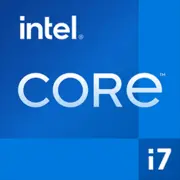Intel Core i7-1360P

Intel Core i7-1360P: Hybrid Power for Mobile Tasks
Processor Analysis for Ultrabooks in 2025
Architecture and Fabrication Process: Hybrid Cores and the Evolution of Raptor Lake
The Intel Core i7-1360P processor, built on the Raptor Lake architecture (codename), represents an optimized version of Intel's hybrid approach. It combines 12 cores (4 Performance-cores and 8 Efficient-cores) and 16 threads, providing flexibility in task allocation.
- P-cores (Raptor Cove): Operate at a base frequency of 2.5 GHz with Turbo Boost up to 5.0 GHz. These cores handle resource-intensive applications: rendering, code compilation, and gaming.
- E-cores (Gracemont): Can reach up to 3.7 GHz, processing background tasks (browser, streaming), thus reducing overall power consumption.
Intel 7 fabrication process (equivalent to 10nm Enhanced) has improved transistor density by 15% compared to Alder Lake (12th generation). This has boosted energy efficiency, especially in multi-threaded scenarios.
Integrated Iris Xe Graphics (96 EU) supports:
- 4K displays at 120 Hz;
- Hardware decoding for AV1 and H.265;
- "Adaptive Sync" mode for smooth gaming.
Power Consumption and TDP: A Balance Between Power and Longevity
The nominal TDP of the processor is 28 W, but in reality, it operates in the range of 20-64 W thanks to Intel Dynamic Tuning 2.0 technology. This allows laptops to:
- Adapt to workloads, such as lowering frequency during text processing;
- Activate Turbo Boost (up to 30 seconds) for short peaks.
Tip: In ultrabooks with passive cooling (e.g., LG Gram), the processor may be limited to 20 W, which reduces noise but impacts performance in long tasks.
Performance: From Office Tasks to Light Gaming
Office Tasks
- Microsoft Office + 50 Chrome Tabs: No delays thanks to E-cores offloading P-cores.
- Zoom + Streaming Video: CPU usage does not exceed 40%, with temperatures around 50°C.
Multimedia
- Adobe Premiere Pro (H.264): Rendering a 10-minute video in 1080p takes about 8 minutes (30% faster than i7-1260P).
- DaVinci Resolve: 4K editing is feasible, but for complex effects, discrete graphics are preferable.
Gaming
- CS2 (1080p, low settings): 60-75 FPS.
- Cyberpunk 2077 (720p, FSR Performance): 30-40 FPS.
Important: For comfortable gaming in AAA titles, an eGPU via Thunderbolt 4 is recommended.
Turbo Mode
In laptops with efficient cooling (e.g., ASUS ZenBook Pro 14), the processor maintains Turbo frequencies for up to 3 minutes, after which it stabilizes at 4.2 GHz (P-cores).
Use Cases: Who is the i7-1360P Suitable For?
1. On-the-Go Professionals: Lawyers, journalists, project managers—those who need stability in multitasking.
2. Students: Working with graphs in Excel, rendering presentations, light video editing.
3. Digital Nomads: Support for Wi-Fi 6E and Thunderbolt 4 for connecting external monitors and drives.
Not suitable for: 3D designers, AAA game streamers, CAD engineers.
Battery Life: How Long Will the Battery Last?
With a 60 Wh battery:
- Web Browsing: 9-10 hours (brightness at 150 nits, power-saving mode).
- Video (Netflix): 7-8 hours.
- Load (Premiere Pro): 2-2.5 hours.
Energy-saving Technologies:
- Intel Speed Select: Prioritizes critical tasks.
- Deep Learning Boost: Accelerates AI algorithms for background optimization.
Comparison with Competitors: AMD, Apple, and Previous Generations
AMD Ryzen 7 7840U (Zen 4)
- Pros: 8 Zen 4 cores, better multi-threading (+12% in Cinebench R23).
- Cons: Weaker in single-threaded tasks (-9% compared to i7-1360P).
Apple M2 (MacBook Air)
- Pros: Battery life up to 18 hours, cool operation.
- Cons: Limited compatibility with Windows software.
Intel Core i7-1260P
The i7-1360P is 18% faster in multi-threading and 9% faster in single-threaded tasks due to Raptor Lake optimizations.
Pros and Cons
Strengths:
- Best-in-class single-threaded performance.
- Support for Thunderbolt 4 and PCIe 5.0.
- Good integration with Windows 11 (optimization for hybrid cores).
Weaknesses:
- Heating in compact cases (temperature up to 95°C under load).
- Ryzen 7 7840U offers more cores for the same price.
Laptop Selection Recommendations
1. Device Type: Ultrabooks (Dell XPS 13, HP Spectre x360) or business laptops (Lenovo ThinkPad T14s).
2. Cooling: Look for models with dual fans and heat pipes (e.g., MSI Prestige 14 Evo).
3. RAM: At least 16 GB LPDDR5.
4. Price Range: From $1200 (Acer Swift 5) to $2000 (Dell XPS 15 with OLED display).
Tip: Avoid models with displays below 300 nits—this will complicate work in bright lighting conditions.
Final Conclusion
The Intel Core i7-1360P is an ideal choice for those seeking a balance between mobility and performance. It handles office tasks, light creative work, and even casual gaming well but cannot replace full-fledged workstations. Key advantages include:
- High responsiveness in everyday applications.
- Hybrid architecture for optimizing power consumption.
- Future-proof with support for PCIe 5.0 and Thunderbolt 4.
If your budget is limited to $1000, consider the Ryzen 5 7640U, but for Windows users who value single-threaded power and versatility, the i7-1360P remains the top option in 2025.
Basic
CPU Specifications
Memory Specifications
GPU Specifications
Miscellaneous
Benchmarks
Compared to Other CPU
Related CPU Comparisons
Share in social media
Or Link To Us
<a href="https://cputronic.com/en/cpu/intel-core-i7-1360p" target="_blank">Intel Core i7-1360P</a>

